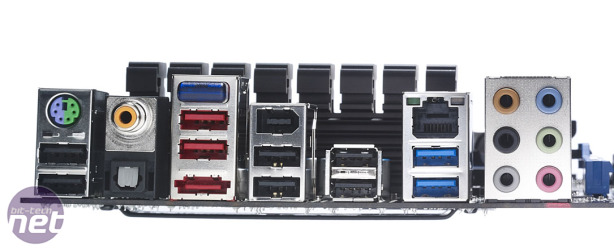Pure Black P67 Hydra Layout
The layout of the Pure Black is fine for the most part, although there are some quirks which are worth noting. The first of these is that the primary 16x PCI-E slot is very close to the RAM slots. This is necessary to accommodate the Lucid Hydra chip between the first and second 16x PCI-E slots, but it also means that you can’t open the lower retention catches on the RAM slots when you insert a graphics card, forcing you to remove your graphics card if you want to remove or add RAM.This is actually a relatively common problem on smaller boards, such as the Asus Maximus IV Gene-Z, but while Asus avoided the problem by using RAM slots with a retention clip on only the upper end; Sapphire has not done this. The location of the Lucid Hydra chip also means that the Pure Black has only six expansion slots rather than the customary seven.
On a more positive note, it’s good to see that the majority of the SATA ports are aligned parallel to the PCB to aid cabling, and that the chipset heatsink isn’t too large. The power sockets are well positioned too, including the extra Molex socket in the bottom right of the board, which needs to be populated if you’re using more than two graphics cards.
The other dominant characteristic of the board is the towering black heatsink that sits imperiously atop the 6+2-phase processor power circuitry to the right of the CPU socket. The heatsink did a good job of keeping the power circuitry cool during our testing, but we can’t help thinking its styling is a little bland. Its height was also cause for concern; it’s one of the tallest VRM heatsinks we’ve ever seen, which could potentially cause problems with oversized CPU coolers. That said, we had no trouble installing the large Titan Fenrir we used for testing.
Pure Black P67 Hydra Overclocking
You’d be mad to purchase a P67 or Z68 board and not attempt to overclock it (assuming, of course, that you’ve paired it with a K-series LGA1156 CPU) so overclockability makes up a hefty wedge of our testing for such boards. As a result, we spent a fair amount of time fiddling around in the EFI of the Pure Black; an experience which was rewarding, if a little frustrating.The EFI itself was a little disappointing, as it looks the same as a traditional BIOS. This is an approach we’ve seen from a number of the less established motherboard manufacturers, and it contrasts sharply with the slickly styled interfaces on show from Asus and MSI (and to a lesser extent ASRock). The options available within the EFI are well organised at least, with all the overclocking and overvolting options collected into one sub-menu.
Overclocking the Pure Black proved to be relatively simple, although we did have to contend with some of the foibles of the Sapphire EFI. We first tried overclocking our CPU via the Non Turbo Ratio Override option, for example, as this was the only multiplier-related option initially available in the CPU configuration menu. Unfortunately, booting into Windows showed this to have made no change to our CPU frequency, forcing us back to the drawing board.
A little more investigation showed that you need to enable EIST to reveal the CPU Turbo Boost Ratio Limit options. Increasing these pushed the processor past its rated speed.
Once we knew this quirk, it was a relatively simple task to push our CPU up to 4.8GHz - a good, if not spectacular overclock. To achieve this we had to pump 1.48V through the CPU, 1.2V through the PCH and give 1.1V to the CPU VSA. We also pushed the CPU PLL up to 1.9V and the CPU VTT to 1.2V. We've seen other boards push the same CPU to 5GHz and 5.1GHz, but a 4.8GHz is a decent showing from the Pure Black nevertheless.

MSI MPG Velox 100R Chassis Review
October 14 2021 | 15:04











Want to comment? Please log in.